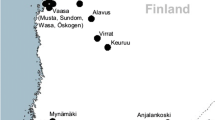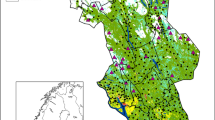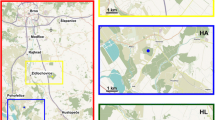Abstract
Populations of northern small rodents have previously been observed to fluctuate in spatial synchrony over distances ranging from tens to hundreds of kilometers between sites. It has been suggested that this phenomenon is caused by common environmental perturbations, mobile predators or dispersal movements. However, very little focus has been given to how the physical properties of the geographic area over which synchrony occurs, such as landscape composition and climate, affect spatial population dynamics. This study reports on the spatial and temporal properties of vole population fluctuations in two areas of western Finland: one composed of large interconnected areas of agricultural farmland interspersed by forests and the other highly dominated by forest areas, containing more isolated patches of agricultural land. Furthermore, the more agricultural area exhibits somewhat milder winters with less snow than the forested area. We found the amplitude of vole cycles to be essentially the same in the two areas, suggesting that the relative amount of predation on small rodents by generalist versus specialist predators is similar in both areas. No seasonal differences in the timing of synchronization were observable for Microtus voles, whereas bank vole populations in field habitats appeared to become synchronized primarily during winter. Microtus populations in field habitats exhibited smaller spatial variation and a higher degree of synchrony in the more continuous agricultural landscape than in the forest-dominated landscape. We suggest that this inter-areal difference is due to differences in the degree of inter-patch connectivity, with predators and dispersal acting as the primary synchronizing agents. Bank vole populations in field habitats were more synchronized within the forest-dominated landscape, most likely reflecting the suitability of the inter-patch matrix and the possibility of dispersal. Our study clearly indicates that landscape composition needs to be taken into account when describing the spatial properties of small rodent population dynamics.





Similar content being viewed by others
References
Adler GH (1994) Tropical forest fragmentation and isolation promote asynchrony among populations of a frugivorous rodent. J Anim Ecol 63:903–911
Andersson M, Erlinge S (1977) Influence of predation on rodent populations. Oikos 29:591–597
Andreassen HP, Ims RA (1998) The effects of experimental habitat destruction and patch isolation on space use and fitness parameters in female root vole Microtus oeconomus. J Anim Ecol 67:941–952
Andrén H, Angelstam P, Lindström E, Widén E (1985) Differences in predation pressure in relation to habitat fragmentation: an experiment. Oikos 45:273–277
Angelstam P, Lindström E, Widen P (1984) Role of predation in short-term population fluctuations of some birds and mammals in Fennoscandia. Oecologia 62:199–208
Benton TG, Lapsley CT, Beckerman AP (2001) Population synchrony and environmental variation: an experimental demonstration. Ecol Lett 4:236–243
Bernstein C, Kacelnik A, Krebs CJ (1991) Individual decisions and the distribution of predators in a patchy environment. II. The influence of travel costs and structure of the environment. J Anim Ecol 60:205–225
Bernstein C, Auger P, Poggiale JC (1999) Predator migration decisions, the ideal free distribution, and predator-prey dynamics. Am Nat 153:267–281
Bjørnstad ON, Ims RA, Lambin X (1999a) Spatial population dynamics: analyzing patterns and processes of population synchrony. Trends Ecol Evol 11:427–432
Bjørnstad ON, Stenseth NC, Saitoh T (1999b) Synchrony and scaling in dynamics of voles and mice in northern Japan. Ecology 80:622–637
Blasius B, Huppert A, Stone L (1999) Complex dynamics and phase synchronization in spatially extended systems. Nature 399:354–359
Cattadori IM, Hudson PJ, Merler S, Rizzoli A (1999) Synchrony, scale and temporal dynamics of rock partridge (Alectoris graeca saxatilis) populations in the Dolomites. J Anim Ecol 68:540–549
Cattadori IM, Merler S, Hudson PJ (2000) Searching for mechanisms of synchrony in spatially structured gamebird populations. J Anim Ecol 69:620–638
Chatfield C (1989) The analysis of time series: an introduction. Chapman & Hall, London
Elton CS (1924) Periodic fluctuations in numbers of animals: their causes and effects. Br J Exp Biol 2:119–163
Erlinge S, Göransson G, Hansson L, Högstedt G, Liberg O, Nilsson IN, Nilsson T, von Schantz T, Sylvén M (1983) Predation as a regulating factor in small rodent populations in southern Sweden. Oikos 40:36–52
FMI (1994) Monthly climate observations in Finland. Finnish Meteorological Institute, Helsinki
Grenfell BT, Wilson K, Finkenstädt BF, Coulson TC, Murray S, Albon SD, Pemberton JM, Clutton-Brock TH, Crawley MJ (1998) Noise and determinism in synchronized sheep dynamics. Nature 391:674–677
Hanski I, Henttonen H (1996) Predation on competing vole species: a simple explanation of complex patterns. J Anim Ecol 65:220–232
Hanski I, Woiwod IP (1993) Spatial synchrony in the dynamics of moth and aphid populations. J Anim Ecol 62:656–668
Hanski I, Hansson L, Henttonen H (1991) Specialist predators, generalist predators, and the microtine rodent cycle. J Anim Ecol 60:353–367
Hanski I, Henttonen H, Korpimäki E, Oksanen L, Turchin P (2001) Small-rodent dynamics and predation. Ecology 82:1505–1520
Hansson L (1971) Small rodent food, feeding and population dynamics: a comparison between granivorous and herbivorous species in Scandinavia. Oikos 22:183–198
Hansson L (1983) Competition between rodents in successional stages of taiga forests: Microtus agrestis vs. Clethrionomys glareolus. Oikos 40:258–266
Hansson L (1984) Predation as the factor causing extended low densities in microtine cycles. Oikos 43:255–256
Hansson L (1987) An interpretation of rodent dynamics as due to trophic interactions. Oikos 50:308–318
Hansson L (1999) Intraspecific variation in dynamics: small rodents between food and predation in changing landscapes. Oikos 86:159–169
Hansson L (2002) Dynamics and trophic interactions of small rodents: landscape or regional effects on spatial variation? Oecologia 130:259–266
Hansson L, Henttonen H (1985) Gradients in density variations of small rodents: the importance of latitude and snow cover. Oecologia 67:394–402
Hansson L, Henttonen H (1988) Rodent dynamics as community processes. Trends Ecol Evol 3:195–200
Heikkilä J, Below A, Hanski I (1994) Synchronous dynamics of microtine rodent populations on islands in Lake Inari in northern Fennoscandia: evidence for regulation by mustelid predators. Oikos 70:245–252
Henttonen H (1985) Predation causing extended low densities on microtine cycles: further evidence from shrew dynamics. Oikos 44:156–157
Henttonen H, Kaikusalo A, Tast J, Viitala J (1977) Interspecific competition between small rodents in subarctic and boreal ecosystems. Oikos 29:581–590
Holyoak M (2000) Habitat patch arrangement and metapopulation persistence of predators and prey. Am Nat 156:378–389
Holyoak M, Lawler SP (1996) The role of dispersal in predator-prey metapopulation dynamics. J Anim Ecol 65:640–652
Huitu O, Koivula M, Korpimäki E, Klemola T, Norrdahl K (2003) Winter food supply limits growth of northern vole populations in the absence of predation. Ecology (in press)
Ims RA, Andreassen HP (2000) Spatial synchronization of vole population dynamics by predatory birds. Nature 408:194–196
Ims RA, Steen H (1990) Geographical synchrony in microtine population cycles: a theoretical evaluation of the role of avian predators. Oikos 57:381–387
Ims RA, Yoccoz NG (1997) Studying transfer in metapopulations: Emigration, migration and colonization. In: Hanski I, Gilpin M (eds) Metapopulation biology: ecology, genetics and evolution. Academic Press, London, pp 247–265
Kalela O (1962) On the fluctuations in the numbers of arctic and boreal small rodents as a problem of production biology. Ann Acad Sci Fenn (Ser A IV B) 66:1–38
Kendall BE, Bjørnstad ON, Bascompte J, Keitt TH, Fagan WF (2000) Dispersal, environmental correlation, and spatial synchrony in population dynamics. Am Nat 155:628–636
Klemola T, Korpimäki E, Norrdahl K, Tanhuanpää M, Koivula M (1999) Mobility and habitat utilization of small mustelids in relation to cyclically fluctuating prey abundances. Ann Zool Fenn 36:75–82
Klemola T, Koivula M, Korpimäki E, Norrdahl K (2000) Experimental tests of predation and food hypotheses for population cycles of voles. Proc R Soc Lond B 267:351–356
Koenig WD (1999) Spatial autocorrelation of ecological phenomena. Trends Ecol Evol 14:22–26
Korpimäki E (1986) Predation causing synchronous decline phases in microtine and shrew populations in western Finland. Oikos 46:124–127
Korpimäki E (1987) Composition of owl communities in four areas in western Finland: importance of habitats and interspecific competition. Acta Regiae Soc Sci Litt Gothob Zool 14:118–123
Korpimäki E (1992) Population dynamics of Fennoscandian owls in relation to wintering conditions and between-year fluctuations of food. In: Galbraith CA, Taylor IR, Percival S (eds) The ecology and conservation of European owls. Joint Nature Conservation Committee (UK Nature Conservation, No 5), Peterborough, pp 1–10
Korpimäki E, Krebs CJ (1996) Predation and population cycles of small mammals: a reassessment of the predation hypothesis. BioScience 46:754–764
Korpimäki E, Norrdahl K (1989) Predation of Tengmalm's owls: numerical responses, functional responses and dampening impact on population fluctuations of microtines. Oikos 54:154-164
Korpimäki E, Norrdahl K (1991) Numerical and functional responses of kestrels, short-eared owls, and long-eared owls to vole densities. Ecology 72:814–826
Korpimäki E, Norrdahl K (1998) Experimental reduction of predators reverses the crash phase of small-rodent cycles. Ecology 79:2448–2455
Korpimäki E, Norrdahl K, Rinta-Jaskari T (1991) Responses of stoats and least weasels to fluctuating food abundances: is the low phase of the vole cycle due to mustelid predation? Oecologia 88:552–561
Korpimäki E, Norrdahl K, Klemola T, Pettersen T, Stenseth NC (2002) Dynamic effects of predators on cyclic voles: field experimentation and model extrapolation. Proc R Soc Lond B 269:991–997
Krebs CJ, Myers JH (1974) Population cycles in small mammals. Adv Ecol Res 8:267–399
Lambin X, Elston DA, Petty SJ, MacKinnon JL (1998) Spatial asynchrony and periodic travelling waves in cyclic populations of field voles. Proc R Soc Lond B 265:1491–1496
Lande R, Engen S, Saether B-E (1999) Spatial scale of population synchrony: environmental correlation versus dispersal and density regulation. Am Nat 154:271–281
Lawrence WS (1988) Movement ecology of the red milkweed beetle in relation to population size and structure. J Anim Ecol 57:21–35
Littell RC, Milliken GA, Stroup WW, Wolfinger RD (1996) SASSystem for Mixed Models. SAS Institute, Cary, NC
Lomolino MV (1989) Bioenergetics of cross-ice movements by Microtus pennsylvanicus, Peromyscus leucopus and Blarina brevicauda. Holarct Ecol 12:213–218
MacKinnon JL, Petty SJ, Elston DA, Thomas CJ, Sherrat TN, Lambin X (2001) Scale invariant spatio-temporal patterns of field vole density. J Anim Ecol 70:101–111
Mackin-Rogalska R, Nabaglo L (1990) Geographic variation in cyclic periodicity and synchrony in the common vole, Microtus arvalis. Oikos 59:343–348
Martinsson B, Hansson L, Angelstam P (1993) Small mammal dynamics in adjacent landscapes with varying predator communities. Ann Zool Fenn 30:31–42
Mihok S (1984) Life history profiles of boreal meadow voles (Microtus pennsylvanicus). Winter ecology of small mammals. Spec Publ Carnegie Mus Nat Hist 10:91–102
Mikkola H (1983) Owls of Europe. T & A D Poyser, Carlton
Moran PAP (1953) The statistical analysis of the Canadian lynx cycle. I. Structure and prediction. Aust J Zool 1:163–173
Myers JH (1998) Synchrony in outbreaks of forest Lepidoptera: a possible example of the Moran effect. Ecology 79:1111–1117
Myrberget S (1973) Geographical synchronism of cycles of small rodents in Norway. Oikos 24:220–224
Norrdahl K, Korpimäki E (1993) Predation and interspecific competition in two Microtus voles. Oikos 67:149–158
Norrdahl K, Korpimäki E (1995) Mortality factors in a cyclic vole population. Proc R Soc Lond B 261:49–53
Norrdahl K, Korpimäki E (1996) Do nomadic avian predators synchronize population fluctuations of small mammals? A field experiment. Oecologia 107:478–483
Norrdahl K, Korpimäki E (2000) Do predators limit the abundance of alternative prey? Experiments with vole-eating avian and mammalian predators. Oikos 91:528–540
Norrdahl K, Korpimäki E (2002) Seasonal changes in the numerical responses of predators to cyclic vole populations. Ecography 25:428–438
Paradis E, Baillie SR, Sutherland WJ, Gregory RD (1999) Dispersal and spatial scale affect synchrony in spatial population dynamics. Ecol Lett 2:114–120
Petty SJ, Lambin X, Sherratt TN, Thomas CJ, Mackinnon JL, Coles CF, Davison M, Little B (2000) Spatial synchrony in field vole Microtus agrestis abundance in coniferous forest in northern England: the role of vole-eating raptors. J Appl Ecol 37:136–147
Post E, Forchhammer MC (2002) Synchronization of animal population dynamics by large-scale climate. Nature 420:168–171
Ranta E, Kaitala V (1997) Travelling waves in vole population dynamics. Nature 390:456
Ranta E, Kaitala V, Lindström J, Lindén H (1995a) Synchrony in population dynamics. Proc R Soc Lond B 262:113–118
Ranta E, Lindström J, Lindén H (1995b) Synchrony in tetraonid population dynamics. J Anim Ecol 64:767–776
Ranta E, Kaitala V, Lundberg P (1997) Population variability in space and time: the dynamics of synchronous population dynamics. Science 278:1621–1623
Ranta E, Kaitala V, Lindström J (1999) Spatially autocorrelated disturbances and patterns in population synchrony. Proc R Soc Lond B 266:1851–1856
Ripa J (2000) Analysing the Moran effect and dispersal: their significance and interaction in synchronous population dynamics. Oikos 90:175–187
Royama T (1992) Analytical population dynamics. Chapman & Hall, London
Schwartz MK, Mills LS, McKelvey KS, Ruggiero LF, Allendorf FW (2002) DNA reveals high dispersal synchronizing the population dynamics of Canada lynx. Nature 415:520–522
Sherratt JA, Lambin X, Thomas CJ, Sherratt TN (2002) Generation of periodic waves by landscape features in cyclic predator-prey systems. Proc R Soc Lond B 269:327–334
Solantie R (2000) Snow depth on January 15th and March 15th in Finland 1919–98, and its implications for soil frost and forest ecology. Meteorological Publications no 42, Finnish Meteorological Institute, Helsinki
Solantie R, Drebs A, Hellsten E, Saurio P (1996) Timing and duration of snow cover in Finland during 1961–1993. Meteorological Publications no 34, Finnish Meteorological Institute, Helsinki
Sonerud GA (1986) Effect of snow cover on seasonal changes in diet, habitat, and regional distribution of raptors that prey on small mammals in boreal zones of Fennoscandia. Holarct Ecol 9:33–47
Steen H, Ims RA, Sonerud GA (1996) Spatial and temporal patterns of small-rodent population dynamics at a regional scale. Ecology 77:2365–2372
Stenseth NC, Saitoh T (1998) The population ecology of the vole Clethrionomys rufocanus: a preface. Res Popul Ecol 40:1–3
Tomppo E, Katila M, Moilanen J, Mäkelä H, Peräsaari J (1998) Kunnittaiset metsävaratiedot 1990–94. Folia For 4B:619–839
Ydenberg RC (1987) Nomadic predators and geographical synchrony in microtine population cycles. Oikos 50:270–272
Ylönen H, Viitala J (1985) Social organization of an enclosed winter population of the bank vole Clethrionomys glareolus. Ann Zool Fenn 22:353–358
Ylönen H, Viitala J (1991) Social overwintering and food distribution in the bank vole Clethrionomys glareolus. Holarct Ecol 14:131–137
Acknowledgements
We would like to thank the members of the Ornithological Society of Suomenselkä, who conducted the extensive fieldwork and provided us with the data used in this study. In particular, we want to acknowledge the contributions of J. Ryssy, O. Ihantola, J. Kolari, J. Koskela, J. Löytömäki, E. Rajala, E. Rautiainen, P. Sulkava, R. Sulkava, R. Viitasaari, and T. Yks-Petäjä. Harri Hakkarainen, Tero Klemola, and Janne Sundell provided valuable comments on the manuscript. This study was financially supported by the Turku University foundation and the Graduate School of Evolutionary Ecology (grants to O.H.) and the Academy of Finland (grants to E.K.; project no. 63525, 64542, 69014, 71110, and 74131).
Author information
Authors and Affiliations
Corresponding author
Rights and permissions
About this article
Cite this article
Huitu, O., Norrdahl, K. & Korpimäki, E. Landscape effects on temporal and spatial properties of vole population fluctuations. Oecologia 135, 209–220 (2003). https://doi.org/10.1007/s00442-002-1171-6
Received:
Accepted:
Published:
Issue Date:
DOI: https://doi.org/10.1007/s00442-002-1171-6




